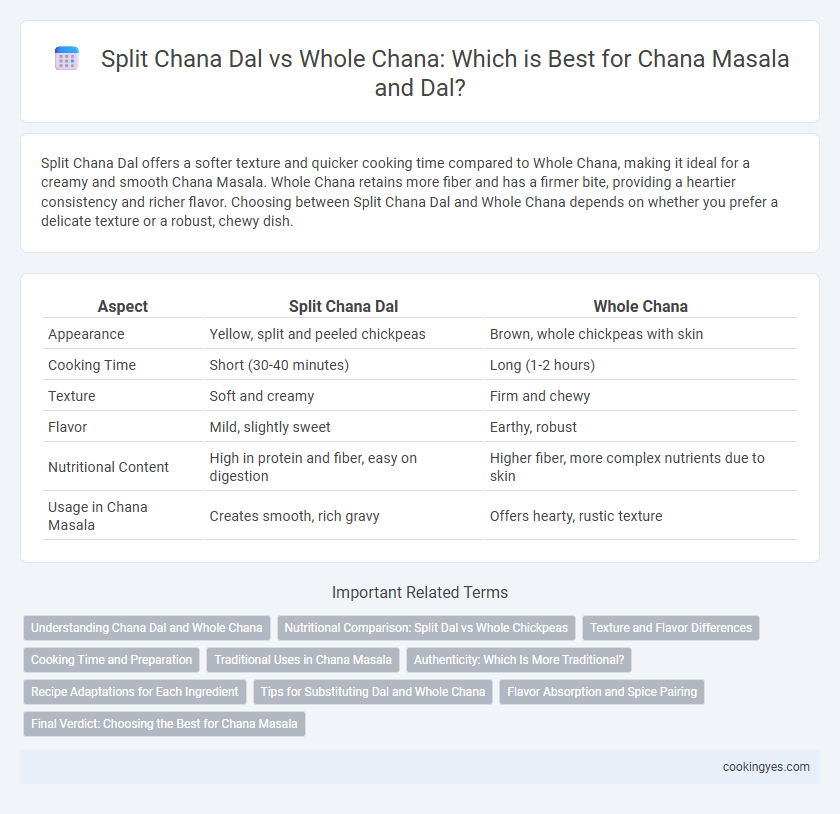Split Chana Dal offers a softer texture and quicker cooking time compared to Whole Chana, making it ideal for a creamy and smooth Chana Masala. Whole Chana retains more fiber and has a firmer bite, providing a heartier consistency and richer flavor. Choosing between Split Chana Dal and Whole Chana depends on whether you prefer a delicate texture or a robust, chewy dish.
Table of Comparison
| Aspect | Split Chana Dal | Whole Chana |
|---|---|---|
| Appearance | Yellow, split and peeled chickpeas | Brown, whole chickpeas with skin |
| Cooking Time | Short (30-40 minutes) | Long (1-2 hours) |
| Texture | Soft and creamy | Firm and chewy |
| Flavor | Mild, slightly sweet | Earthy, robust |
| Nutritional Content | High in protein and fiber, easy on digestion | Higher fiber, more complex nutrients due to skin |
| Usage in Chana Masala | Creates smooth, rich gravy | Offers hearty, rustic texture |
Understanding Chana Dal and Whole Chana
Chana Dal is split and polished kala chana that cooks faster and absorbs spices efficiently, making it ideal for smooth, creamy chana masala. Whole Chana, also known as kala chana or black chickpeas, has a tougher texture and richer earthy flavor, offering a more robust bite but requiring longer cooking time. Understanding these differences helps optimize texture, flavor, and cooking duration for authentic chana masala dishes.
Nutritional Comparison: Split Dal vs Whole Chickpeas
Split chana dal offers faster cooking time and easier digestion compared to whole chickpeas, while both provide rich sources of protein, dietary fiber, and essential minerals like iron and magnesium. Whole chickpeas retain more of their natural fiber and complex carbohydrates, promoting better blood sugar control and sustained energy release. Both forms are versatile in chana masala, with nutritional benefits making them ideal for a balanced, high-protein vegetarian diet.
Texture and Flavor Differences
Split chana dal has a softer texture and cooks faster than whole chana, resulting in a creamier consistency ideal for chana masala. Whole chana offers a firmer bite and nuttier flavor, enhancing the dish's overall robustness. Using split chana dal creates a smooth base, while whole chana provides a chewier, more textured experience.
Cooking Time and Preparation
Split Chana Dal cooks significantly faster than whole chana due to its broken structure, reducing cooking time from over an hour to about 30-40 minutes. Preparation of split chana dal typically involves rinsing and soaking for 30 minutes to an hour, while whole chana requires extended soaking of 8-12 hours to soften. Using split chana dal in chana masala offers convenience without compromising texture, making it ideal for quicker meal preparation.
Traditional Uses in Chana Masala
Split chana dal, made from hulled and split chickpeas, is traditionally favored in Chana Masala for its quicker cooking time and softer texture, allowing the spices to infuse deeply. Whole chana, or black chickpeas (kala chana), offers a nuttier flavor and firmer bite, often used in rustic or regional variations of the dish. Both forms maintain high protein content and essential nutrients, but split chana dal enhances the traditional creamy consistency of classic Chana Masala recipes.
Authenticity: Which Is More Traditional?
Whole chana is more traditional and authentic for chana masala, as it preserves the natural texture and flavor sought in classic recipes. Split chana dal, being hulled and split, cooks faster but slightly alters the dish's traditional rustic consistency and bite. Authentic Indian chana masala recipes typically emphasize the use of whole chickpeas to maintain the original taste and appearance of the dish.
Recipe Adaptations for Each Ingredient
Split chana dal cooks faster and yields a softer texture in chana masala, making it ideal for quick recipes and creamy gravies. Whole chana requires longer soaking and cooking times, resulting in a firmer bite and nuttier flavor that enhances rustic or hearty versions of the dish. Adjusting spices and cooking durations based on whether split or whole chana is used will optimize flavor absorption and texture in the final chana masala.
Tips for Substituting Dal and Whole Chana
Split chana dal cooks faster and yields a softer texture ideal for creamy chana masala, while whole chana offers a firmer bite and nuttier flavor but requires longer soaking and cooking times. When substituting split chana dal for whole chana, reduce cooking time by half and monitor texture to avoid overcooking. Using whole chana in recipes calling for split dal demands extended soaking (8-12 hours) and cooking (60-90 minutes) to achieve tenderness suitable for chana masala.
Flavor Absorption and Spice Pairing
Split Chana Dal absorbs flavors more effectively in Chana Masala due to its reduced size and exposed surface area, allowing spices like cumin, coriander, and garam masala to penetrate deeply for a rich, well-blended taste. Whole Chana retains a firmer texture, offering a nuttier flavor but slower spice absorption, resulting in a more distinct, layered spice profile. For recipes emphasizing bold spice infusion, Split Chana Dal enhances the overall flavor harmony, while Whole Chana suits dishes where texture contrast is preferred.
Final Verdict: Choosing the Best for Chana Masala
Split chana dal offers a softer texture and quicker cooking time, making it ideal for smooth, creamy chana masala. Whole chana provides a firmer bite and nuttier flavor, preferred for rustic, hearty dishes with distinct chickpea pieces. For authentic chana masala, split chana dal generally delivers a balanced blend of flavor and texture, optimizing both cooking efficiency and taste.
Split Chana Dal vs Whole Chana for Chana Masala Infographic

 cookingyes.com
cookingyes.com